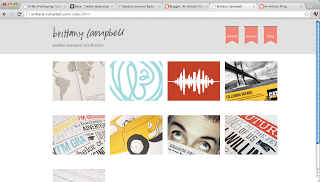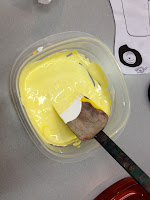Recently I have been trying to build my portfolio and make it stronger. This longing for perfection was probably set on by a few factors. 1- I've had the opportunity to be the "industry professional" on the other side of the table at a few interviews, job fairs and portfolio reviews. I'm seeing mistakes that I've made and I'm seeing really awesome stuff that I could use to improve my portfolio. 2- My interests for employment have changed a little bit and I want to include pieces that speak directly to the kind of work I want to do. 3- I am in the process of developing my own style and I believe my current portfolio doesn't show that off as much as I would like it to.
I think I am in a very unique and opportunistic situation. I am, myself, an emerging designer. I consider these portfolio owners my "competition" in the job market. Being able to see what my competition has gives me a huge benefit. So what does that mean for all you internet lovelies out there? It means I'm going to help you. While, yes, you are competition, you are my friends and it makes me happy to see you succeed. So here I go. A list (and corresponding explanations) that will help your portfolio, make you look professional and ace your interviews (even though we all know you're scared to death.)
1. You can't do what you want if you're not already doing it.
While at a portfolio review, I asked a soon-to-be-grad to be what she wanted to ultimately do. She said package design. There was not a single piece of package design in her book. It's hard to convince someone to hire you to do something you can't even prove you know how to do. Would you buy a pair of non-refundable shoes without trying them on? No. Let your potential employer try you on. Having a bunch of ads in your portfolio is great but if your applying for a graphic design position at
Branding and Rebranding R-Us they want to see if you can make a decent logo.
Which brings me to another point. KNOW YOUR AUDIENCE! That's, like, the number one rule of design, right? Just like designing a logo for a client's customers, you have to design your portfolio for your customer, aka, potential employer. Show off pieces that deal with the same kind of work they do. I'm not saying you should be exclusive but maybe you can talk more about your process if you're showing work for a food product while interviewing for an in-house position at Kraft.
2. Have a purpose.
Design, whether you like it or not, is an ART. If you don't treat it like one you might find yourself out of a job. You are no different than Da Vinci, Van Gogh or any of those other fine artists. Every brush stroke was done purposefully. Every design decision you make should be done purposely. If I hear one more person say "I choose to do that because it looked nice." I will scream! Of course it looks nice. I'm asking you why you did what you did to see if you KNOW why it looks nice. It's one thing to know good design. It's another to be able to explain good design. This is something employers love. It makes the firm look knowledgable in front of clients. It also makes you an easier person to work with because you know how to use words to make people understand your ideas and thought process.
3. Be a perfectionist
As a designer you have a responsibility to pay attention to detail. While your portfolio may or may not include real world work, you should treat it as such. This work may not be a way for you to get a pay check but it's going into a large book that will someday get you a job that gives lots of paychecks.
I was interviewing a guy who made a hypothetical campaign for a hypothetical shoe company. He wanted the campaign to extend into Facebook. He took a screen shot of Coca-Cola's Facebook page and edited the photos and statuses to reflect his campaign. The one thing he forgot to edit? The name of the Facebook page. There was all these logos for his hypothetical shoe company but the whole page was still called "Coca-Cola." The job is in the details, folks. It would have taken him 30 seconds to fix.
Make sure that your type is set on grids. Check for typos. Clean up those rags. Kern. Tidy up vectors. Consistency. Have good print quality.
Your portfolio is your lawyer. It should be on your side so make sure it says good things about you. It is one of two lines of defense. The other is you.
4. GET A WEB PRESENCE.
So I met this guy at a portfolio review and I loved his work. I asked for his business card and gave him my personal card, not even my office card, like, I mean my personal business card. He didn't have a website and his email was something with a whole bunch of numbers @gmail.com. DOWN FALL. I looked him right in the eye and said "The second this portfolio review is over you go home and put all your stuff on behance.net. You have great stuff and people need to see it." I went back to my office and wanted to show my co-workers the wonderful stuff this kid had but I couldn't because he didn't have an online presence. It made me really sad.
Behance.net is a great place to put your stuff if you don't have a domain name or website. But please don't stick with that for too long. I'm not kidding, this weekend get on godaddy and buy yourself a domain name, it's like 12 bucks. Ever heard of virb.com or cargocollective? They have easy portfolios, too.
5. Get a big kid email address.
So I will admit my email address was originally b_campbell89 [at] hotmail (yes, hotmail.) . com. That's embarrassing. Then I got a gmail and switched that "hot" for a "g". Not so embarrassing but still pretty bad. Then I had a professional and friend tell me that the 89 at the end of my email address what giving away my age. Which could be a bad thing. He explained that some of the people doing the hiring out there started working before I was even born. The year 1989 seems like yesterday and I don't want an employer thinking I was born yesterday.
If you google "use my own domain name on gmail" you will find countless tutorials on how to actually create your own email address. For example: me@brittany-campbell.com. It's free, as long as you already own the domain name (which you should be using for your website anyway.)
I think this is the info I used.
6. Presentation
At an interview, a potential employer is staring across the table from you, someone they will probably end up putting infront of clients. If they have a boss, they will probably have to put you in front of their boss and explain why they choose to hire you. If you get hired don't embarrass the person that just went out on a limb for you. Be professional. Be professional in the interview. They're not only critiquing your work, their critiquing your presentation skills. I've compiled a short list of dos and don'ts to help aid in this tricky but important section.
DOs:
- Start and finish with a handshake.
- Bring your portfolio.
- BREATHE
- Talk positively about your work.
- Provide reasoning for your design choices.
- Make sure you understand the questions.
- Answer questions directly, short and to the point.
- Dress to impress. Better to over dress than under dress.
- Accept feedback politely.
- Follow up with thank you emails or letters
- Ask questions.
DON'Ts:
- Dont' be late. Always plan for the unexpected.
- Don't explain you're sweaty because you ran to get a cab then it got lost and...
- Don't apologize. Stay confident and explain your design choices. This business is fake it 'til you make it, baby.
- Don't be afraid of silence. Let the employer think.
- Don't talk negatively about your work.
While presentation of yourself is important, it isn't the only thing you need to be focused on. They medium in which you present your portfolio is very important. Depending on what kind of work you do, you may or may not want to present digitally. I still print my book. Many employers have liked that. It's easy to see, employers don't feel like they're invading your privacy by touching it, and it shows your production skills.
With iPads and laptops becoming more popular, many interviewees are opting for digital portfolios, which, can be completely acceptable. This can also be a good idea if you have a lot of work for the web. Make sure your presentation looks just as professional as a printed book would. I've seen pdf portfolios on interviewees' laptops that don't even allow us to see a full piece of work. It's also very difficult to see on a 13" monitor. It's unprofessional to see other files on your desktop or your desktop wall paper displaying the pictures of you and your boo. For an iPad make sure the files are easy to flip through and require little navigation.
Whether you print or have a digital version, make sure you pay attention to detail. This includes using high quality files, high quality printing, clean crop marks, no dog-ears on pages, no coffee smudges, ect.
GREAT TIP! If you have made any bus ads, in store displays, or package design, show how it's used. It's one thing to see it flat on a page but it speaks volumes when we can see it in a picture being used in a store, or on a bus, or on the actual package. This will help the interviewer understand your process and the final piece. Also do this for books. If you make an annual report PRINT IT and photograph it or bring it along with you.
The coolest thing I have ever seen was a student who created a first aid kit. He had great color choices and perfect icons on everything from the bandages to the scissors to the aspirin. It was awesome. He actually had the kit with him and had pictures of it in his portfolio. If he would have just had the .ai files laid out on a page I wouldn't have been so impressed.
I hope this has helped you and if any of you have good things to add I would love to hear your thoughts and pointers.

































